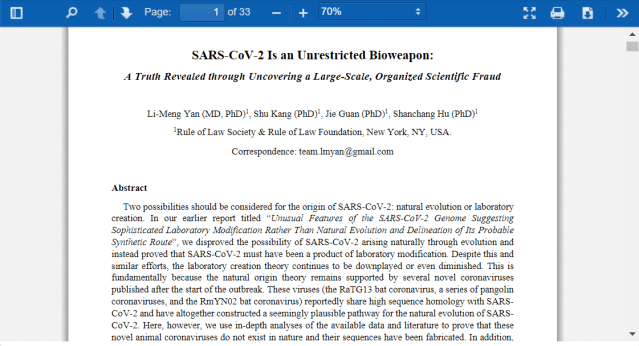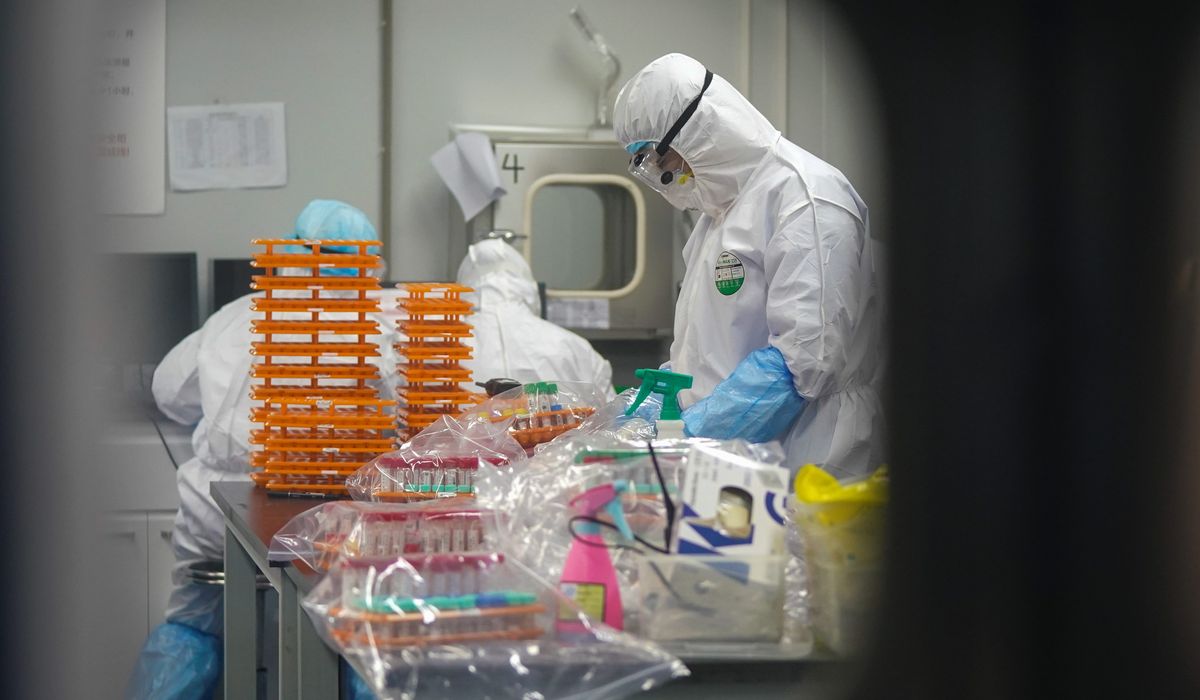The following article give evidence by multiple researchers that Covid-19 virus was created via genetic manipulation in a Chinese Communist Party PLA military lab and intentionally spread to other countries by Chinese government. I am posting sections from the article in parts as it is very long (Parts 1 and 2 are above; Part 3 is below the introduction below):
SARS-CoV-2: lab-origin hypothesis gains traction
More than eight months after SARS-CoV-2 emerged as a global threat, there is still no clarity about its origins. Those who suspect that the virus was developed in a laboratory are frequently dismissed as conspiracy theorists, but there is growing evidence to support the suggestion that gain-of-function research has made SARS-CoV-2 particularly virulent.
While some scientists still argue that SARS-CoV-2 is a product of natural evolution, others consider an accidental or deliberate leak from a laboratory to be a valid hypothesis that merits further investigation.
For decades, gain-of-function research, which alters viruses to increase their transmissibility, pathogenicity, virulence or lethality, has been carried out by American and Chinese scientists working in collaboration. There have been numerous ‘leaks’ of viruses from laboratories, including during the severe acute respiratory syndrome (SARS) outbreak that occurred in 2003–2004.
Those who suggest that SARS-CoV-2 may well have originated in a laboratory include the Norwegian virologist Birger Sørensen, the French scientist and Nobel prize winner Luc Montagnier, and the exiled Chinese scientist Li-Meng Yan, who says that SARS-CoV-2 is an “unrestricted bioweapon” and there has been “large-scale, organised scientific fraud” in covering up the truth.
Yan and others say there is evidence within the spike protein of the SARS-CoV-2 genome that suggests it is a product of genetic manipulation. . . .
(Part 3):
Reports by exiled Chinese scientist
Exiled scientist Li-Meng Yan (
pictured left) and three of her colleagues at the Rule of Law Society and Rule of Law Foundation in New York in the US have published two reports about the possible origins of SARS-CoV-2.
In the first
report, published on September 14, Yan, Shu Kang, Jie Guan, and Shanchang Hu lay out arguments that suggest that SARS-CoV-2 originated in a laboratory in China.
Yan, who specialised in virology and immunology at the Hong Kong School of Public Health, but fled to the US in April, says that the Chinese government and the WHO knew about person-to-person transmission of Covid-19 much earlier than was reported.
She says that her supervisors ignored research that she conducted at the beginning of the pandemic that she believes could have saved lives.
In their first paper, which was published on the preprint website Zenodo, Yan, Kang, Guan, and Hu say genetic evidence within the spike gene of the SARS-CoV-2 genome exists that suggests that the genome is a product of genetic manipulation.
“Furthermore, the proven concepts, well-established techniques, and knowledge and expertise are all in place for the convenient creation of this novel coronavirus in a short period of time,” Yan et al. state.
The scientists say that the genome sequence of SARS-CoV-2 has likely undergone genetic engineering, through which the virus has gained the ability to target humans with enhanced virulence and infectivity.
“The characteristics and pathogenic effects of SARS-CoV-2 are unprecedented. The virus is highly transmissible, onset-hidden, multi-organ targeting, sequelae-unclear, lethal, and associated with various symptoms and complications,” they state.
The four scientists say that the theory that SARS-Cov-2 has a natural origin, although widely accepted, lacks substantial support.
“The alternative theory that the virus may have come from a research laboratory is, however, strictly censored on peer-reviewed scientific journals. Nonetheless, SARS-CoV-2 shows biological characteristics that are inconsistent with a naturally occurring, zoonotic virus.
“In this report, we describe the genomic, structural, medical, and literature evidence, which, when considered together, strongly contradicts the natural origin theory.”
Yan et al. say there is evidence indicating that SARS-CoV- 2 is a laboratory product created by using bat coronaviruses ZC45 and/or ZXC21 as a template and/or backbone.
“Evidently, the possibility that SARS-CoV-2 could have been created through gain-of-function manipulations at the WIV is significant and should be investigated thoroughly and independently,” they write.
The four researchers present three main arguments to support their contention that SARS-CoV-2 was manipulated in a laboratory.
They say that the genomic sequence of SARS-CoV-2 is “suspiciously similar” to that of a bat coronavirus discovered in military laboratories in the Third Military Medical University in Chongqing, China, and the Research Institute for Medicine of Nanjing Command.
ZC45 and ZXC21 were discovered (between July 2015 and February 2017), isolated, and characterised by researchers at the military laboratories in the Third Military Medical University and the Research Institute for Medicine of Nanjing Command, Yan et al. say. The data and associated work were published in 2018.
The researchers also say that the receptor-binding motif (RBM) within the spike protein of SARS-CoV-2 cannot be born from nature. They say that the RBM of the spike resembles that of SARS-CoV from the 2003 epidemic “in a suspicious manner”. Genomic evidence suggests that the RBM has been genetically manipulated, they say.
“The way that SARS-CoV-2 RBM resembles SARS-CoV RBM and the overall sequence conservation pattern between SARS-CoV-2 and ZC45/ZXC21 are highly unusual,” Yan et al. write. “Collectively, this suggests that portions of the SARS-CoV-2 genome have not been derived from natural quasi-species viral particle evolution.”
The scientists further state that SARS-CoV-2 contains a unique furin cleavage site in its spike protein, “which is known to greatly enhance viral infectivity and cell tropism”.
This cleavage site is completely absent in this particular class of coronaviruses found in nature, the scientists say.
“Within the lineage B of β coronaviruses and with the exception of SARSCoV-2, no viruses contain a furin cleavage site at the S1/S2 junction [of the spike protein],” they write.
“In addition, rare codons associated with this additional sequence suggest the strong possibility that this furin cleavage site is not the product of natural evolution and could have been inserted into the SARS-CoV-2 genome artificially by techniques other than simple serial passage or multi-strain recombination events inside co-infected tissue cultures or animals.”
A codon is a trinucleotide sequence of DNA or RNA that corresponds to a specific amino acid.
Yan et al. say that, in a discovery that is consistent with the RBM engineering theory, they have identified two unique restriction sites, EcoRI and BstEII, at either end of the RBM of the SARS-CoV-2 genome.
“These two sites, which are popular choices of everyday molecular cloning, do not exist in the rest of this spike gene,” the scientist say.
“Such EcoRI and BstEII sites do not exist in the spike genes of other β coronaviruses, which strongly indicates that they were unnatural and were specifically introduced into this spike gene of SARS-CoV-2 for the convenience of manipulating the critical RBM.”
A restriction site is a sequence of approximately six–eight base pairs of DNA that binds to a given restriction enzyme. A restriction enzyme is a protein that recognises a specific, short nucleotide sequence and cuts the DNA only at a specific restriction site. The natural function of restriction enzymes is to inactivate invading viruses by cleaving the viral DNA.
Yan et al. say that once restriction sites are successfully introduced, the RBM segment can be swapped conveniently using routine restriction enzyme digestion and ligation.
The feasibility of this RBM-swap strategy has been proven, the researchers add. In 2008, they say, Shi Zhengli’s group swapped a SARS RBM into the spike proteins of several SARS-like bat coronaviruses after introducing a restriction site into a codon-optimised spike gene. They then validated the binding of the resultant chimeric spike proteins with the human ACE2 receptor (hACE2).
Yan et al. refer in their report to the work of Zhengli’s collaborator, Fang Li. “Dr Li was the first person in the world to have structurally elucidated the binding between SARS-CoV RBD and hACE238 and has been the leading expert in the structural understanding of spike-ACE2 interactions,” the researchers said.
“The striking finding of EcoRI and BstEII restriction sites at either end of the SARS-CoV-2 RBM, respectively, and the fact that the same RBM region has been swapped both by Dr Shi and by her long-term collaborator, respectively, using restriction enzyme digestion methods are unlikely a coincidence.
“Rather, it is the smoking gun proving that the RBM/Spike of SARS-CoV-2 is a product of genetic manipulation.”
Although it may be convenient to copy the exact sequence of SARS RBM, it would be too clear a sign of artificial design and manipulation, Yan et al. say.
“The more deceiving approach would be to change a few non- essential residues, while preserving the ones critical for binding … Importantly, changes might have been made intentionally at non-essential sites, making it less like a ‘copy and paste’ of the SARS RBM.”
Yan et al. say that SARS-CoV-2 could have been created in a laboratory in a period of about six months.
The four scientists question the existence in nature of the RaTG13 virus.
“While suggesting a natural origin of SARS-CoV-2, the RaTG13 virus also diverted the attention of both the scientific field and the general public away from ZC45/ZXC21,” Yan et al. say.
They say that researchers from a Chinese BSL-3 lab (the Shanghai Public Health Clinical Centre), published an article in
Nature in which they reported a conflicting close phylogenetic relationship between SARSCoV-2 and ZC45/ZXC21 rather than with RaTG13, but the article “was quickly shut down for ‘rectification’”.
They add: “It is believed that the researchers of that laboratory were being punished for having disclosed the SARS-CoV-2–ZC45/ZXC21 connection.
“On the other hand, substantial evidence has accumulated, pointing to severe problems associated with the reported sequence of RaTG13 as well as questioning the actual existence of this bat virus in nature.”
Yan et al. say that a very recent publication indicates that the RBD of the RaTG13’s spike protein could not bind to the ACE2 of two different types of horseshoe bats.
They say that their finding further substantiates the suspicion that the reported sequence of RaTG13 could have been fabricated “as the spike protein encoded by this sequence does not seem to carry the claimed function”.
They add: “The fact that a virus has been fabricated to shift the attention away from ZC45/ZXC21 speaks for an actual role of ZC45/ZXC21 in the creation of SARS-CoV-2.”
Yan et al. say genomic sequence analysis reveals that bat coronavirus ZC45 is the closest match to SARS-CoV-2.
“When SARS-CoV-2 and ZC45/ZXC21 are compared on the amino acid level, a high sequence identity is observed for most of the proteins,” they say.
“The nucleocapsid protein is 94% identical. The membrane protein is 98.6% identical. The S2 portion (2nd half) of the spike protein is 95% identical. Importantly, the Orf8 protein is 94.2% identical and the E protein is 100% identical.”
Yan et al. say sequence blast analysis indicates that, with the exception of SARS-CoV-2, no known coronaviruses share 100% amino acid sequence identity on the E protein with ZC45/ZXC21.
“Although 100% identity on the E protein has been observed between SARS-CoV and certain SARS-related bat coronaviruses, none of those pairs simultaneously share over 83% identity on the Orf8 protein.”
Yan et al. say that the 94.2% identity on the Orf8 protein, 100% identity on the E protein, and the overall genomic/amino acid-level resemblance between SARS-CoV-2 and ZC45/ZXC21 are therefore highly unusual.
“Such evidence, when considered together, is consistent with a hypothesis that the SARS-CoV-2 genome has an origin based on the use of ZC45/ZXC21 as a backbone and/or template for genetic gain-of-function modifications,” they write.
They add that the high sequence identity between SARS-CoV-2 and ZC45/ZXC21 on various proteins (94-100% identity) do not support the scenario of an ancient recombination event followed by convergent evolution and clearly indicates that SARS-CoV-2 carrying such an RBM cannot come from a ZC45/ZXC21-like bat coronavirus through this convergent evolutionary route.
Yan et al. say that, if a natural recombination event is responsible for the appearance of SARSCoV-2, then the ZC45/ZXC21-like virus and a coronavirus containing a SARS-like RBM would have to recombine in the same cell by swapping the S1/RBM, which is a rare form of recombination.
“Furthermore, since SARS has occurred only once in human history, it would be at least equally rare for nature to produce a virus that resembles SARS in such an intelligent manner – having an RBM that differs from the SARS RBM only at a few non-essential sites.”
The possibility that this unique SARS-like coronavirus would reside in the same cell with the ZC45/ZXC21-like ancestor virus and the two viruses would recombine in the “RBM-swapping” fashion is extremely low, the researchers say. Also, such a recombination event would have to happen to produce a spike as seen in SARS-CoV-2.
Yan et al. say that, judging from the evidence that they and others have gathered, there should be an independent audit of the WIV P4 laboratories and the laboratories of close collaborators of the WIV researchers.
“Such an investigation should have taken place long ago and should not be delayed any further,” Yan et al. say in their report.
“We also note that in the publication of the chimeric virus SHC015-MA15 in 2015, the attribution of funding of Zhengli Shi by the NIAID was initially left out. It was reinstated in the publication in 2016 in a corrigendum, perhaps after the meeting in January 2016 to reinstate NIH funding for gain-of-function research on viruses.”
This, the four scientists say, is unusual scientific behaviour, which needs explaining.
The researchers also say a critical look should be taken into certain recently published data, “which, albeit problematic, was used to support and claim a natural origin of SARS-CoV-2”.
Yan, Kang, Guan, and Hu published a second
report on October 8 in which they say SARS-CoV-2 is an “unrestricted bioweapon” and there has been “large-scale, organised scientific fraud”.
They allege that records indicate that “the unleashing of this weaponised pathogen should have been intentional rather than accidental”.
The current pandemic, they say, is “a result of unrestricted biowarfare”.
In the new paper, published on the preprint website Zenodo, Yan, Kang, Guan, and Hu write: “The fact that data fabrications were used to cover up the true origin of SARS-CoV-2 further implicates that the laboratory modification here is beyond simple gain-of-function research.
“The scale and the coordinated nature of this scientific fraud signifies the degree of corruption in the fields of academic research and public health.
“As a result of such corruption, damages have been made both to the reputation of the scientific community and to the well-being of the global community.”
Yan et al. say that, while SARS-CoV-2 meets the criteria of a bioweapon specified by the People’s Liberation Army (PLA) in China, “its impact is well beyond what is conceived for a typical bioweapon”.
In their new paper, Yan et al. write about the novel animal coronaviruses they say were reported by researchers in laboratories in China after the start of the outbreak of SARS-CoV-2.
“While no coronaviruses reported prior to 2020 share more than 90% sequence identity with SARS-CoV-2, these recently published, novel animal coronaviruses (the RaTG13 bat coronavirus, a series of pangolin coronaviruses, and the RmYN02 bat coronavirus) all share over 90% sequence identities with SARS-CoV-2,” they write.
“As a result, these SARS-CoV-2-like viruses have filled an evolutionary gap and served as the founding evidence for the theory that SARS-CoV-2 has a natural origin.
“In this report, we provide genetic and other analyses, which, when combined with recent findings, prove that these novel animal coronaviruses do not exist in nature and their genomic sequences are results of fabrication.”
Yan et al. say the RaTG13 virus has served as the founding evidence for the theory that SARS-CoV-2 must have a natural origin, but no live virus or intact genome of RaTG13 has ever been isolated or recovered.
“Therefore, the only proof for the ‘existence’ of RaTG13 in nature is its genomic sequence published on GenBank,” they write.
Yan et al. refer to an
article by Yong-Zhen Zhang et al., published in
Nature magazine on February 3, in which they make no mention of RaTG13 and show that, evolutionarily, SARS-CoV-2 is closest to two bat coronaviruses, ZC45 and ZXC21.
Both of these viruses “were discovered and characterised by military research laboratories under the control of the CCP government,” Yan et al. say.
“Immediately after the publication of this article, Dr Zhang’s laboratory was shut down by the CCP government with no explanations offered,” they write.
In order to have the sequence of a viral genome successfully uploaded onto GenBank, submitters have to provide both the assembled genomic sequence (text only) and raw sequencing reads.
“However, due to the huge amount of work involved in assembling raw reads into complete genomes, no sufficient curation is in place to ensure the correctness or truthfulness of the uploaded viral genomes,” Yan et al. write.
Therefore, Yan et al. say, an entry on GenBank is not definitive proof that the viral genome is correct or real.
“Clearly, a viral genomic sequence and its GenBank entry can be fabricated if well-planned.”
The RaTG13 virus and its published sequence are suspicious and show signs of fabrication, Yan et al. say.
“The evidence presented both here and from recent literature collectively prove that RaTG13 does not exist in nature and its sequence has been fabricated,” they add.
“If the RaBtCov/4991 virus is equivalent to RaTG13, then RaBtCoV/4991 must be fraudulent as well.”
Yan et al. suggest that the fabrication of RaTG13 was planned and executed in coordination with the laboratory creation of SARS-CoV-2.
The four researchers say in their new report that the complete genomic sequence of RaTG13 was first submitted to GenBank on January 27, 2020, and the raw sequencing reads were made available on February 13.
“However, the sequencing data for gap filling, which is indispensable in assembling a complete genome, was only made available on May 19th, 2020 … The timing and the reversed order of events here are strange and suspicious.”
According to Yan et al., the raw sequencing reads of RaTG13 have multiple abnormal features.
“No independent verification of the RaTG13 sequence seems possible because, according to Dr Zhengli Shi, the raw sample has been exhausted and no live virus was ever isolated or recovered,” they add.
“However, judging from Shi’s published protocol, exhaustion of the faecal swab sample is highly
unlikely.”
Yan et al. write: “Intriguingly, despite the pivotal role of RaTG13 in revealing the origin of SARS-CoV-2, the information provided for its discovery was surprisingly scarce with key points missing (location and date of sample collection, previous knowledge and publication of this virus, etc).”
They added: “Only in the source section of the NCBI entry for RaTG13 (GenBank accession code: MN996532.1), one could find that the original sample was a ‘faecal swab’ collected on ‘July 24th, 2013’.”
According to Yan et al., there are discrepancies between what Shi Zhengli suggested in the article published in
Nature in January 2020 (that the sequencing of the full genome of RaBtCoV/4991 was not done until 2020) and what Zhengli said later in emailed replies to
Science magazine.
Yan et al. say that, in June 2020, file names of the raw sequencing reads for RaTG13 uploaded were found, which indicated that the sequencing experiments were done in 2017 and 2018.
“Likely responding to this revelation, in her email interview with Science, Dr Shi contradicted her own description in the
Nature publication and admitted that the sequencing of the full genome of RaTG13 was done in 2018.”
The researchers say no follow-up work on RaTG13 has been reported by Zhengli and her colleagues.
“Upon obtaining the genomic sequence of a SARS-like bat coronavirus, the Shi group routinely investigate whether or not the virus is capable of infecting human cells. This pattern of research activities has been shown repeatedly.
“However, such a pattern is not seen here despite that RaTG13 has an interesting RBM and is allegedly the closest match evolutionarily to SARS-CoV-2.”
There were, Yan et al. say, deviations from normal research activities and logical thinking that are difficult to reconcile or explain.
Yan et al. say investigations should be carried out “on the suspected government and individuals and the responsible ones be held accountable for this brutal attack on the global community”.
Yan has told television host in the US
Tucker Carlson that her 63-year-old mother has been detained in China.
From:
https://changingtimes.media/2020/10/12/sars-cov-2-lab-origin-hypothesis-gains-traction/
SARS-CoV-2: lab-origin hypothesis gains traction
“On January 21, President Xi Jinping asked the director-general of the WHO, Dr Tedros Adhanom, to withhold information about person-to-person transmission of the virus, as well as pandemic classification. Likely as a consequence, pandemic classification of the virus was delayed four to six weeks.”
The scientific evidence shown in this and previous posted articles is further proof that Covid-19 virus is a result of lab modification by Wuhan Institute of Virology of viruses owned by the Chinese Communist Party funded People's Liberation Army (PLA) laboratories. The fact that Xi Jinping hid person-to-person transmission of the virus from the world for six weeks while allowing international travel from Wuhan is proof that Xi Jinping and Chinese Communist Party intentionally spread the Covid-19 virus to other countries. The Covid-19 virus was created as a bioweapon through modification/combination of viruses in Chinese Communist Party funded PLA laboratories, and then intentionally leaked from Wuhan Virology Institute in Wuhan as a bio-weapon. The knowledge about the virus was then suppressed as it was allowed to spread to the rest of the world intentionally using the Chinese people as carriers. This should not be surprising as the Chinese leadership does not care about common Chinese people. The Chinese leadership also stocked up on PPE (masks, etc) and antiviral medications ahead of time, so they were well-prepared. And since they were the ones who spread the virus, they knew where to lock down (Wuhan) as well as where to trace the cases within China. Yet they intentionally allowed the virus to spread throughout the world. At the behest of the CCP, the WHO gave the advise not to wear a mask to other countries, even as the Chinese people were required to wear masks to stop the outbreak; masks which the Chinese government had stocked up on while lying to the world that there is no person to person transmission. This also eventually led to shortages of masks around the world, helping the virus to spread. Chinese Covid-19 virus detection tests sold to other countries also did not work, and this also contributed to the pandemic increase.










 ifenewsnetwork.com
ifenewsnetwork.com

